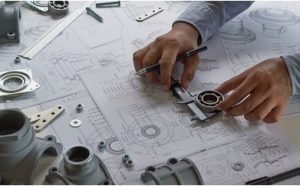
Product development, whether creating components, finished goods, housing, or road construction, begins with an idea. From there, that single idea expands into multiple ideas that must be represented on paper and a computer screen. Someone that’s skilled enough must draw and design the project so that it is visually easy to understand.
To enter today’s workforce in drafting and design technology, employees need college training obtained by earning an associate degree. An associate in occupational studies (AOS) degree provides specific education and skills training that are directly job-related. This is typically the case compared to a community college degree where an abundance of general education courses restricts hands-on training.
Drafting and Design Are Critical Functions of Product Development
Today’s products must be masterfully crafted to precise dimensions and functionality. It all begins with accurate drawings and designs that include specifications, and in many cases, materials needed, and instructions for the projects. Without specially trained drafting and design personnel, product development and completion suffer in quality level.
Effective drawings are achieved by following these simple guidelines:
- Create drawings with pen and paper and transfer to CAD – 2D and 3D
- Creating and arranging all the necessary views
- Indicate dimensions and specifications correctly and accurately
- Apply tolerances, aka designing around reality
- Submit to your supervisor for comments
- Make modifications as needed
All these skills are taught in an associate of occupational studies (AOS) degree in a technical college.
Associate (AOS) Degree Versus Community College Associate Degree
There is a philosophical and practical difference between these two types of college programs. This chart compares and contrasts the significant points of difference.
Component Technical College Community College
Focus Skills for specific career General knowledge and skills
Education More hands-on More classroom work
Training More job-related Less job-related
Job Preparation Provides transferable skills Less transferable skills
Faculty Involvement More one-on-one training Less one-on-one training
Job Placement Very active for students Varies with community college
Time to Completion Less than 1 year to 2 years 2 years or longer
Costs Affordable Affordable but typically higher
The essential difference is that more technical college education and training translates into practical job skills.
| “To enter today’s workforce in drafting and design technology, employees need college training obtained by earning an associate degree. An associate in occupational studies (AOS) degree provides specific education and skills training that is directly job-related.” |
What Students Learn in a Drafting and Design Technology Program
Students learn both the basics and some advanced training in a typical technical college
 AOS drafting and design technology program. Here’s a typical curriculum:
AOS drafting and design technology program. Here’s a typical curriculum:
Classes and Labs
-
-
- • Freehand sketching, multi-view, and auxiliary drawing
-
• Drafting equipment, AutoCAD software, and Windows Systems
• Pictorial and assembly drawing and graphic engineering data
• Cartesian and advanced math and technical writing
Other Training
- Interpreting data from field measurements, notes, and existing drawings
- A choice of drafting specializations including piping, civil/structural, architectural, instrumentation, and electrical
Types of Entry-Level Jobs Open to Graduates
Today’s drafting and design careers are categorized into these specialties:
- Architectural – Houses, apartments, condos, duplexes, government buildings
- Civil Engineering – Roads, bridges, dams, plants, pipelines
- Electrical/Electronic – Components, wiring, computers, electronic devices
- Graphic Design – Advertising, marketing, logos, sales
- Illustrator – Websites, magazines, newspapers, books
- Landscape – Lawns, golf courses, local and state parks
- Mechanical – Manufacturing, automotive, parts, equipment
This variety of specializations makes a career in drafting and design technology more appealing. Your college instructors will explain even more opportunities for those who are well-prepared with an associate degree.
A Choice Place to Earn Technology Degrees
ITI Technical College has been training students for technical careers since 1973 and is accredited by the Accrediting Commission of Career Schools and Colleges. Its technology programs prepare students to meet the employment needs of the Louisiana and Gulf Coast business and industry communities.
ITI graduates are placed nationwide in entry-level jobs to meet the job demands for trained technicians. Check out our Associate of Occupational Studies (AOS) Degree in Drafting and Design Technology and you will see why we are a choice place to earn a degree.
For more information about graduation rates, the median debt of students who completed the program, and other important information, please visit our website at: https://iticollege.edu/disclosures/



